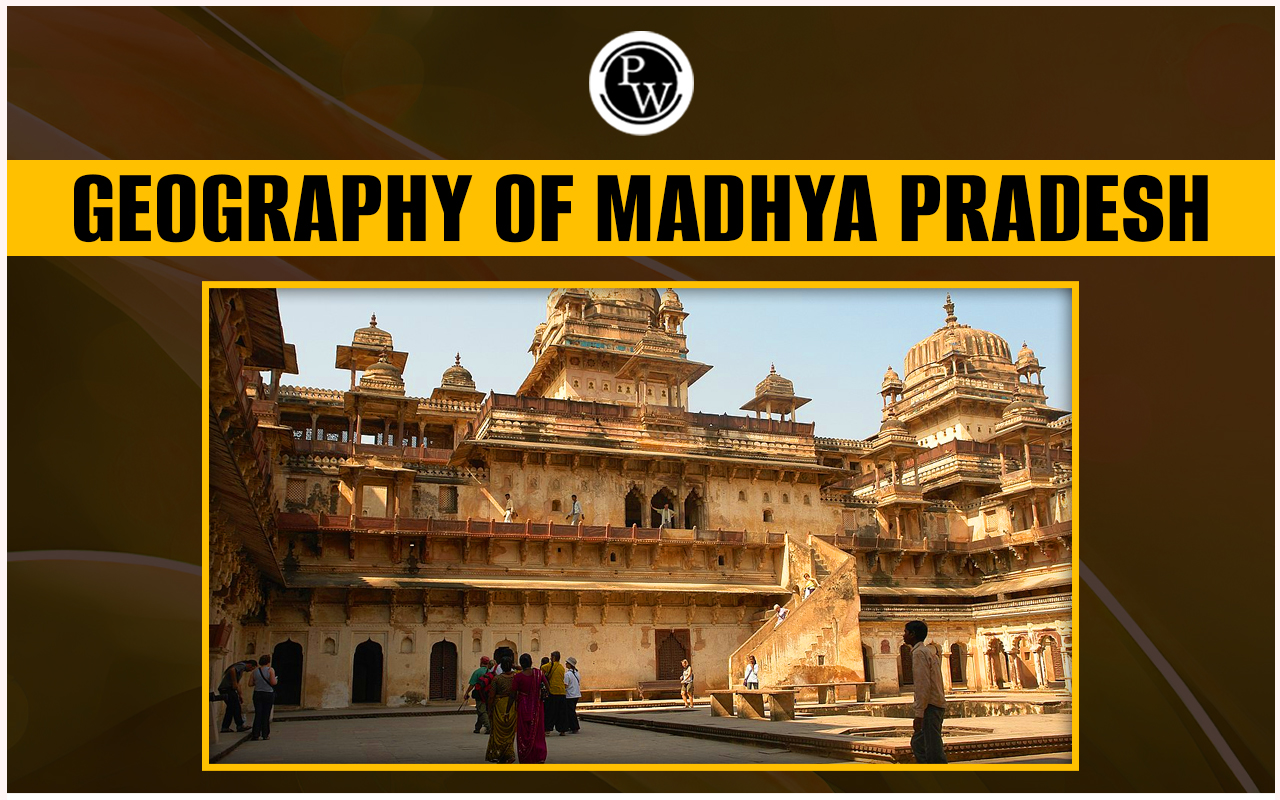
Geography of Madhya Pradesh: Madhya Pradesh is referred to as the "Heart of India" because it is located in the centre of the Indian map, Madhya Pradesh is a land of diverse landscapes, rich culture, and historical significance. Madhya Pradesh is comprised of fascinating geographical tapestry that ranges from large mountain ranges and dense forests to fertile plains and river valleys. Understanding the geography of Madhya Pradesh is necessary to acknowledge its cultural diversity, natural beauty, and economic potential.
This guide post on the Geography of Madhya Pradesh explores and discusses the various geographical aspects of Madhya Pradesh, including its topography, climate, rivers, forests, wildlife, and natural resources.
Location and Topography in Geography of Madhya Pradesh
The Geography of Madhya Pradesh is diverse in nature, characterized by its strategic location at the heart of India. The mixed topography of Madhya Pradesh includes mountain ranges, plateaus, and fertile plains.
Geographical Position
Madhya Pradesh is centrally located in India, from the north it is bordered by Uttar Pradesh, from the east it is bordered by Chhattisgarh, from the south it is bordered by Maharashtra to the south, from the west it is bordered by Gujarat, and Rajasthan to the northwest. This strategic position makes it an essential junction for trade and cultural exchange across the country.
- Latitude: 21°6' to 26°54' North
- Longitude: 74° to 82°47' East
Topographical Features
Madhya Pradesh's topography is varied, comprising hills, plateaus, and plains, making it a region of significant geographical interest.
Vindhya and Satpura Ranges
The Vindhya Range runs across the state from west to east, creating a natural divide between the northern plains and the southern plateau. The Satpura Range , located to the south, is known for its dense forests and wildlife.
- Vindhya Range: Forms the northern boundary of the Narmada valley.
- Satpura Range: Stretches across the southern part, contributing to the region's rugged terrain.
Malwa Plateau
The Malwa Plateau is a significant geographical region in northwestern Madhya Pradesh, which is characterized by its volcanic origin, black soil, and fertile lands. It is one of the most important agricultural hubs in the state, producing crops like wheat, soybeans, and pulses.
Baghelkhand and Bundelkhand
Baghelkhand and Bundelkhand are located in the northeastern part of the state, known for their rocky landscapes, ancient forts, and cultural heritage. These regions face challenges due to water scarcity and rocky terrain, impacting agriculture.
Climate of Madhya Pradesh in Geography of Madhya Pradesh
The Climate of Madhya Pradesh changes across its expansive landscape, which ranges from humid subtropical in the north to tropical wet and dry in the south. Its climatic diversity supports a range of ecosystems and enhances the geography of Madhya Pradesh.
Climate Zones
Madhya Pradesh experiences a diverse climate due to its mixed topography. As we discussed the climate of Madhya Pradesh ranges from humid subtropical in the north to tropical wet and dry in the south.
- Summer (March to June): Temperatures range from 30°C to 45°C, with the highest temperatures recorded in May.
- Monsoon (July to September): Receives rainfall from the southwest monsoon, with average annual rainfall ranging from 800 mm to 1200 mm.
- Winter (October to February): Temperatures range from 10°C to 27°C, with January being the coldest month.
Rainfall Patterns
The monsoon is a significant factor that plays a crucial role in Madhya Pradesh's agriculture and water resources. The southwestern monsoon winds bring rain, with the eastern parts of the state receiving more precipitation compared to the western regions.
- Western Madhya Pradesh: Receives less rainfall, leading to semi-arid conditions.
- Eastern Madhya Pradesh: Experiences higher rainfall, supporting lush forests and agriculture.
Rivers and Water Resources in Geography of Madhya Pradesh
The Rivers Flowing Through Madhya Pradesh are the crucial key enabler for the state's economy and ecology, providing irrigation, drinking water, and hydroelectric power. The major rivers include the Geography of Madhya Pradesh are as follows:
Major Rivers Flowing Through Madhya Pradesh
Madhya Pradesh comprises a considerable quantity of rivers, which is an important key enabler for its agriculture, industry, and daily life. These rivers contribute to the state's rich alluvial plains and fertile lands.
Narmada River
The Narmada River , known as the "Lifeline of Madhya Pradesh," flows from the west to across the state, creating the famous Narmada Valley. It is a major source of irrigation and hydroelectric power.
- Length: 1,312 km
- Significance: Provides irrigation to the fertile plains and supports several hydroelectric projects.
Tapi River
The Tapi River flows parallel to the Narmada, providing water resources to the southern parts of the state. This valley is known for its rich black soil, suitable for cotton cultivation.
Chambal River
The Chambal River flows in the northern part of Madhya Pradesh, famous for its narrow opening between the hillsides and unique biodiversity. The Chambal Valley is known for its alluvial soil and agricultural activities.
- Tributaries: Kali Sindh, Parbati, and Shipra.
- Significance: Supports agriculture and wildlife sanctuaries.
Son and Betwa Rivers
The Son River , a tributary of the Ganges, and the Betwa River , a tributary of the Yamuna, are important rivers for the eastern regions. These rivers support irrigation and drinking water needs.
Forests and Wildlife in the Geography of Madhya Pradesh
The Flora and Fauna of Madhya Pradesh evolve and produce in its extensive coverage of forest, which is home to diverse ecosystems. The state is a sanctuary for countless species of plants and animals, including endangered tigers and leopards, the Flora and Fauna of Madhya Pradesh is also a significant factor in the enhancement of the Geography of Madhya Pradesh.
Forest Cover
Madhya Pradesh boasts extensive forest cover, with about 31% of its total area under forests. The state's forests are rich in biodiversity and home to numerous plant and animal species.
- Types of Forests: Tropical dry deciduous, moist deciduous, and tropical thorn forests.
- Forest Reserves: Kanha, Bandhavgarh, Pench, and Satpura National Parks.
Wildlife Sanctuaries
The state's diverse ecosystems support a wide range of wildlife, including some endangered species and flora and fauna of Madhya Pradesh. Madhya Pradesh is renowned for its national parks and wildlife sanctuaries, attracting nature enthusiasts and researchers alike.
Kanha National Park
Kanha National Park is one of India's premier tiger reserves, known for its rich biodiversity and conservation efforts. It is home to the majestic Bengal tiger, leopards, barasingha (swamp deer), and numerous bird species.
- Area: 940 sq km
- Significance: Conservation of barasingha and other wildlife species.
Bandhavgarh National Park
Bandhavgarh National Park is famous for its high density of tigers and historical ruins. The park's varied landscapes provide a habitat for many flora and fauna of Madhya Pradesh.
- Area: 450 sq km
- Significance: Known for its high tiger population density.
Panna National Park
Panna National Park is renowned for its efforts in tiger conservation and is a UNESCO Biosphere Reserve. It also features unique landscapes with gorges, plateaus, and the Ken River.
- Area: 542 sq km
- Significance: Successful reintroduction of tigers and diverse ecosystems.
Natural Resources and Economy in Geography of Madhya Pradesh
The Natural Resources of Madhya Pradesh are in large quantity, which contributes to its economic growth and the geography of Madhya Pradesh. The state's mineral wealth includes coal, limestone, and bauxite, vital for various industries.
Mineral Wealth
Madhya Pradesh is rich in mineral resources, contributing significantly to its economy. The state's mineral wealth includes coal, limestone, bauxite, copper, and manganese.
- Coal Reserves: Located in the Singrauli region, supporting thermal power generation.
- Limestone and Bauxite: These minerals are necessary for the cement and aluminium industries.
Agricultural Potential
Agriculture plays an important role in Madhya Pradesh's economy, with fertile plains and favourable climatic conditions supporting diverse crops.
- Major Crops: Wheat, rice, soybeans, pulses, and maize.
- Horticulture: Fruits like oranges, guavas, and mangoes are cultivated extensively.
Industrial Growth
Madhya Pradesh has witnessed significant industrial growth, with sectors like textiles, automobiles, cement, and pharmaceuticals succeeding in recent years. The state's strategic location and large resources make it an attractive destination for industries.
- Industrial Hubs: Indore, Bhopal, Gwalior, and Jabalpur.
Cultural and Historical Significance in the Geography of Madhya Pradesh
The Political Geography of Madhya Pradesh is influenced by its rich cultural heritage and historical sites. The state's diverse tribal communities add to its unique cultural landscape.
Heritage Sites
Madhya Pradesh is a land of historical treasures, with numerous UNESCO World Heritage Sites, ancient temples, forts, and monuments that reflect its rich cultural heritage.
Khajuraho Temples
The Khajuraho Group of Monuments is famous for its stunning architecture and detailed sculptures, depicting various aspects of life and spirituality.
Sanchi Stupa
The Sanchi Stupa , a UNESCO World Heritage Site, is one of the oldest stone structures in India, representing Buddhist art and architecture.
Tribal Communities
Madhya Pradesh is home to several tribal communities, each with unique traditions, art, and crafts. The tribal culture adds vibrancy to the state's cultural tapestry.
Gond and Bhil Tribes
The Gond and Bhil tribes are among the largest tribal communities in the state, known for their rich traditions, music, dance, and crafts.
- Gond Art: Famous for its detailed patterns and vibrant colours, depicting folklore and daily life.
- Bhil Festivals: Celebrated with traditional music, dance, and rituals.
Festivals and Traditions
The cultural diversity of Madhya Pradesh is reflected in its festivals, fairs, and traditions. Major festivals like Diwali, Holi, and Navratri are celebrated with enthusiasm, while traditional fairs like the Kumbh Mela and tribal festivals showcase the state's rich heritage.
Geography of Madhya Pradesh FAQs
Q.1 What is the geographical significance of Madhya Pradesh?
Q.2 How does the topography of Madhya Pradesh affect its climate?
Q.3 What are the major rivers flowing through Madhya Pradesh?
Q.4 What types of soil are found in Madhya Pradesh?
Q.5 What is the status of flora and fauna in Madhya Pradesh?











